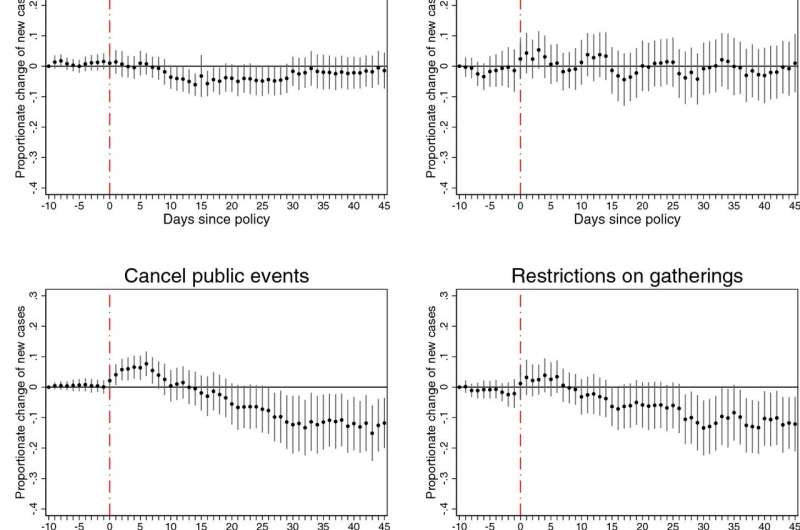Effects of lockdown policies on COVID-19 confirmed new cases (3-day moving average, in logs) with controls for concurrent policies. Credit: Scientific Reports (2021). DOI: 10.1038/s41598-021-81442-x
Konstantinos Tatsiramos, Professor of Labour Economics in the Department of Economics and Management of the University of Luxembourg, and colleagues Nikos Askitas (Coordinator of Data and Technology, IZA-Institute of Labor Economics) and Bertrand Verheyden (Senior Researcher, Luxembourg Institute of Socio-Economic Research) evaluate the effects of 8 lockdown policies on the daily number of confirmed COVID-19 new cases and on the mobility patterns of the populations across 175 countries. The results were published recently in the journal Scientific Reports. These policies are international travel controls, public transport closures, cancelation of public events, restrictions on private gatherings, school and workplace closures, stay-at-home requirements, and internal mobility restrictions (across cities and regions).
Researchers address the question of which policies have proven to be the most effective in containing the virus given the important collateral economic costs that they induce. Since multiple policies were introduced almost simultaneously, the paper develops a novel approach to examine each policy's effect while accounting for the existence of confounding concurrent policies.
The study provides important and robust results. First, the most effective policies at reducing the daily incidence of COVID-19 are the cancelation of public events, restrictions on private gatherings and the closure of schools and workplaces. International travel controls have a significant, though short-lived, effect. Once concurrent policies are controlled for, stay-at-home orders have limited effects, while public transport closures and restrictions on movements across cities and regions have no effect.
The effects of the key policies are mediated through population mobility patterns in a manner consistent with time-use and epidemiological factors. For instance, the cancelation of public events and restrictions on private gatherings reduce exposure to the most populated and dense locations, whereas workplace and school closures reduce contacts in somewhat less dense and populous places but with a much higher frequency.
This econometric framework is suitable for the study of dynamic effects with multiple events, which can be applied in many settings. The researchers plan to use this multiple-event model to study the effects of other policies, such as vaccinations.
Preliminary research results were published in Issue 23 of the journal "COVID Economics, Vetted and Real-Time Papers" from the Centre for Economic Policy Research (CEPR) with the title "Lockdown strategies, mobility patterns and COVID-19."
More information: Nikolaos Askitas et al. Estimating worldwide effects of non-pharmaceutical interventions on COVID-19 incidence and population mobility patterns using a multiple-event study, Scientific Reports (2021). DOI: 10.1038/s41598-021-81442-x
Journal information: Scientific Reports
Provided by University of Luxembourg






















